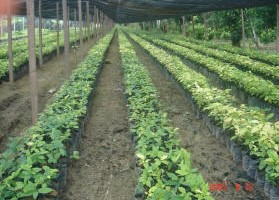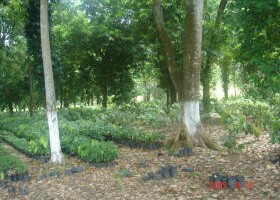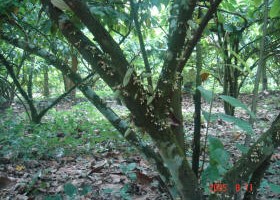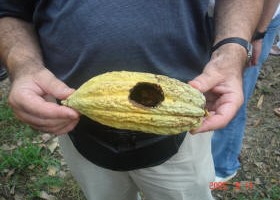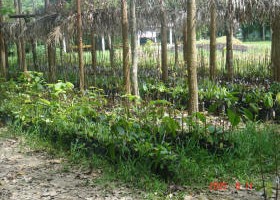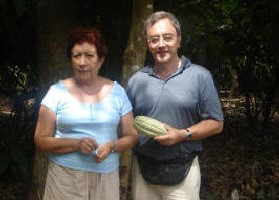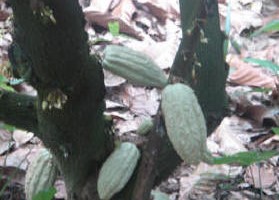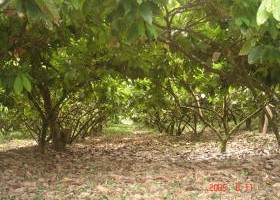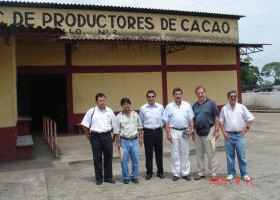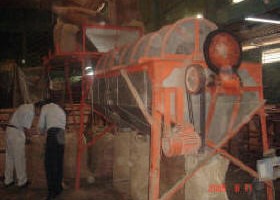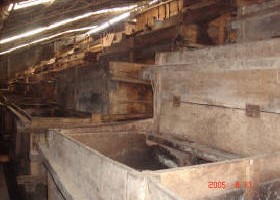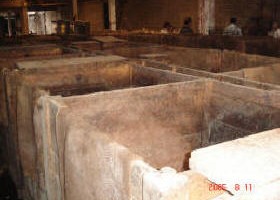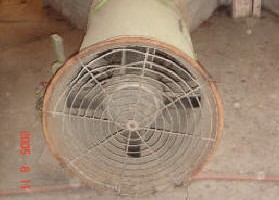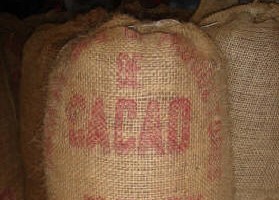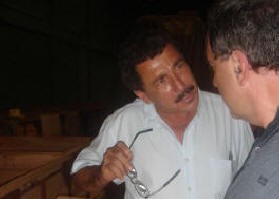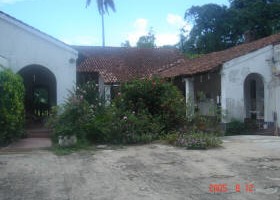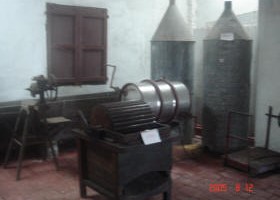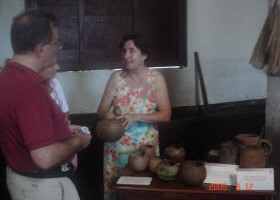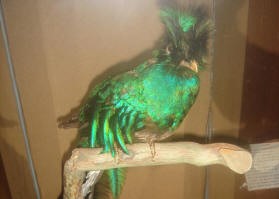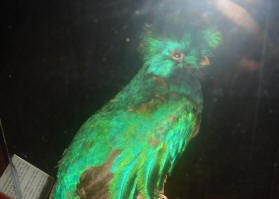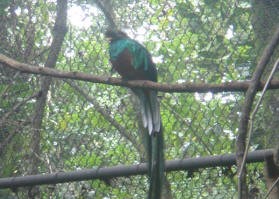Mexico
1) Mayan
There are generally three distinguishable periods in Mayan civilisation.
The pre-classical era
The pre-classical era extends from 2600 BC to 250 AD. From 2000 BC saw the expansion of the Olmec civilisation, which spawned many aspects of the Mayan civilisation.
Archaeological evidence shows that the Mayan ceremonial architecture starts from 1000 BC. It is very difficult to distinguish between the pre-Mayan culture and the Olmec civilisation. The two cultures influenced each other.
Around 300 BC we see a big increase in the number of sites and intense architectural activity, a sign of a big increase in the population. Particularly in the cities of Komchén, Cerros and Tikal. Each site developed in its own way, nevertheless the same red ceramics were used everywhere, an undeniable sign of cultural unity.
Between 50 and 250 AD, traditionally known as the proto-classical period, tensions appeared, either a population crisis or an invasion- no one knows. Seven sites including Cerros and Komchen disappeared, whereas others such as Tikal grew.
The Classical Era
Tikal plays a predominant role in the first part of the classical era, which marks the height of the Mayan culture. In 292, a dated stone slab or stele proves the predominance of this city over the whole Mayan world. Its position seems to be reinforced by the links with the big metropolis of Central America Teotihuacán. These links can be seen in architecture, ceramics and sculpture.
Towards the middle of the VIth century, a slowing down of activities is seen, no more dated monuments were erected. This marked the end of the ancient classical period. A revival was soon organised around the city states which rivaled each other in the prestige stakes. The Mayan culture reached its height: it would last up to the Xth century.
The postclassical era
The postclassical era, from 900 to 1516 ends with the Spanish conquest and marks the demise of cities and the disappearance of monumental engravings. Wars, ecological disasters, famines and a combination of these factors are the reasons generally given to explain this decline.
The Mayan cities in the plains of North Yucatan nevertheless continued to prosper for several more centuries such as Chichen Itza, Uxmal, Edzná, and Coba. After the decline of the Chichen and Uxmal dynasties, the city of Mayapan governed the whole of the Yucatan until the revolt around 1450. When the Spanish arrived, the region was in the hands of small city states.
In the southern highlands, the Mayan culture continued to survive throughout the small kingdoms such as Quiché. It was from this kingdom that one of the best known Mayan mythological texts came: the Popol Vuh.
Mayan hieroglyphic writing continued to be used in the Codex, made from long bands of vegetable fibre covered with lime and folded in accordion style. Four of them have survived: those of Dresde, of Paris, the Troano Codex of Madrid and the Grolier.
The Spanish began their conquest of the Mayan lands around 1520. A few kingdoms nevertheless continued to resist ferociously, such as the last Mayan state, the kingdom of Itza in Guatemala, which didn't fall until 1697.
2) The Olmecs were a people who developed during the Mesoamerican pre-classical period between the XV1th century BC and 150 AD on the territory situated in the northern part of the Tehuantepec isthmus, which includes the southern part of the state of Veracruz, in the western part of Tabasco.
It was very probably the oldest civilisation of Mesoamerica. The best known sites are those of La Venta, San Lorenzo, Tenochtitlan, Tres Zapotes, Chalcantzingo and La Mojarra. The region that the Olmecs occupied between the Gulf of Mexico and the Sierras is known for its heavy rain and so has an abundance of water supplies (lakes, rivers and marshes).
3) Information about the Zapotec people is vague. The beginning of their civilisation is estimated in a very imprecise way around 1500 BC. Until the Spanish invasion, in the XV1th century they were the largest group in the Oaxaca Valley. It is thought that they founded numerous aspects of the Mesoamerican culture by inventing the city-state,a numerical system based on 20, the rebus and a calendar system which were sometimes attributed to the Olmecs. Archaeologists distinguish several phases in the Zapotec civilisation beginning with the occupation of their historic centre Monte Albán.
Period 1: from 500 BC to 280 BC. The population of Monte Albán reached around 10,000 people with significant works of terracing. The growth was consecutive with the domination of the villages of the Oaxaca Valley.
Period II: from 200 BC to 250 AD. The terracing works intensified which indicates greater resources. It's in this period that the characteristic ceramics of this culture appear, with a Mayan influence. The cult of death develops with sepulchral complexes.
Period III: from 250 AD to 700AD: The golden age of the Zapotec civilisation brought with it the construction of monuments which still exist on the present site. The Zaachila dynasty however established its capital at Téozpotlan and so the society became theocratic. The God of Rain, Pitao, is worshipped in four different forms. The city of Mitla was founded during this period.
Period 1V: from 780 AD to 1000 AD. The site of Monte Albán seems to have been gradually abandoned. One hypothesis for this is the scarcity of wood and the exhaustion of the soil.
Period V: from 1000 AD to 1500AD. The tombs from the site served the high ranking Mixtec cemetery when they were installed in the valley. In effect, pushed southwards by the Toltecs and the Chichimecs, they entered into conflict with the Zapotecs. They also conquered Mitla. In 1280,a royal marriage between the two people of close cultures sealed an alliance against the Aztecs. Their descendant Cocijo-pij, died in 1563. As the last Zapotec king, he witnessed the Spanish conquest.
4) " Teotihuacan " was the largest town of pre-Columbian America, in nahuatl, its name means "where men become gods". According to legend, it is where the gods met to plan human creation.
This name is also used when referring to the civilisation that this town dominated, which at its height, included most of Mesoamerica. The town was also referred to as Tollan, the name also used centuries later for the Toltec capital Tula.
Construction started around 300 BC and the town reached its zenith between 300 and 600 when it was the centre of an influential culture. At that time it covered more than 13 km2 and probably had a population of more than 150,000 inhabitants, perhaps even 200,000. Archaeological evidence shows that the town included suburbs of members of other groups from Mesoamerica such as the Mixtecs, the Zapotecs and the Mayans. The town traded obsidienne and other goods with other regions.
The wide central avenue of the town was lined with impressive ceremonial architecture including the huge Pyramid of the Sun,the Pyramid of the Moon and the temple of Quetzalcoatl and several temples and smaller palaces.
In the VIth century Teotihuacán was the sixth largest city in the world with around 200,000 inhabitants. The population lived on produce from irrigated fields in the valley and from the fertile soil of Lake Texcoco, after the marshes had been drained. Salt came from lake salt beds, clay for ceramics from the valley and stone from local quarries.
The expansion of the state of Teotihuacán allowed it to take control of other sources of raw material (obsidienne from Pachuca and Otumba). More than 400 artisans' workshops have been identified, a third of them producing ceramics. They worked with obsidienne, semiprecious stones (jade, onyx) and imported seashells. All these products were used for trading on a local, national and "international" basis. In return, the city received exotic materials: copal, aromatic resin from the coast of the Gulf of Mexico, caudal feathers from the quetzal bird from the Mayan countries
Teotihuacán was then the biggest centre of pilgrimage in Mesoamerica. Hundreds of temples have been identified throughout the town, altars have been found in all the residential areas, with ceramic incense burners and figurines of divinities.
Tlaloc, the God of Rain, his wife Chalchihuitlique, Goddess of Water and Quetzalcoalt, the feathered serpent, appear in the frescoes of temples and palaces
Unfortunately no Teotihuacan texts have been passed down to us, but the town is occasionally mentioned in the texts on Mayan monuments, showing that the Teotihuacan nobility travelled and married local rulers from as far away as the Honduras. The Mayan glyphs mention a spear thrower apparently symbolising the emperor of Teotihuacán who ruled for more than 60 years and imposed his family as Kings of Tikal and Uaxactun in Guatemala. Around 650 the town began to decline. It was sacked and burned, perhaps by Toltec invaders, in around 750.
5) The Toltecs were a people who lived mainly between 1000 and 1380 around their capital Tula near to Teotihuacán in Mexico. The Aztecs would be their successors.
They lived in the central plateau (in the area which today includes the Mexican states of Tlaxcala, Hidalgo, Mexico, Morelos and PueblaIls) A military cast replaced the religious one which controlled society.
Their capital Tula, was conquered by the Chichimecs in 1168.
The ceramics of Mayapán and Matlazinca still use their symbols.
6) Aztecs is the name for a group which includes 12 nahua tribes who founded the present town of Mexico. They were nomads before settling on the central plateau of Mexico. According to legend, they came from a place called Aztlán (white land or according to some translations The country of the Heron). This place was perhaps situated in the north-west of Mexico (we can place it generally in the state of Nayarit).
Their migration was provoked by a bird who from high up in a tree sang tihui which means "let's go". Following the instructions of the bird the Aztecs took to the road around 1160 and making an image of their God and the sun god Huitzilopochtli, they placed it in a cane chair to lead the migration. Historians have little information on this period of Aztec history: a lot of information is based on later writings of Aztec nobles and had probably been embellished and modified for political reasons.
Towards the XIth century/XIIth century the Aztecs arrived in the central region of Mexico. They probably belonged to the Chichimec people composed of seven tribes and who invaded the central Mexico at this time. The Aztecs, the seventh tribe, lived a pretty precarious and wandering existence for 200 years. But this period was also when they adopted the agricultural techniques of the Toltecs, for whom they worked the land or in whose service they fought, and from where their religious concepts and their personal gods took a quasi definitive form - at least until the Tlacaelel reforms.
XIe siècle/XIIe siècle
They settled first on the edge of Lake Texcoco around 1256 before being chased away by the king of Azcapotzalco.
The Toltec king of Colhuacan allowed the Aztecs to settle on the edge of his kingdom in 1299 on infertile land in the region of Tizapan, then offered his daughter in marriage to chief Nopaltzin. He promised to make his wife a " goddess" and kept his word in doing just that...by killing her and offering her as a sacrifice. So the Aztecs were once again chased out.
| Mesoamerican Civilisations | ||
|---|---|---|
| Civilisation | Period | Place |
| Mayans | from XXth century BC to XVIth century AD | In the Yucatán peninsular (Mexico) up to what is now Guatemala. |
| Olmecs | from XIIIth to Vth century BC | In the hollow of the Gulf of Mexico |
| Zapotecs | From VIth century BC to VIIIth century AD. | In the Oaxaca State, in Mexico(Pacific Coast). |
| Teotihuacán | from IInd century BC to VIIIth century AD | In the same town situated in Mexico State in Mexico |
| Toltecs | from Xth century AD to XIIIth century AD. | In Mexico State in Mexico |
| Aztecs | from XIVth to XVIth century AD. | Situated in the region of today's Mexico |
Mexico
The second country visited by Choco-Story, the Bruges chocolate Museum, as part of the Grand tour of cocoa producing countries, had to be Mexico.
In fact, Mexico comprises part of the large Central American region where cocoa consumption first began.
It is however probable that cocoa was not first consumed in Mexico
This tree came from the Amazon region and therefore, in its progressive development, had necessarily to first pass through countries such as Guatemala, Honduras and Belize.
The oldest trace discovered so far is in the jug which was unearthed in Colha Belize.
It dates from approximately 500 BC and certainly contained a liquid based on cocoa, because traces of theobromine remained at the bottom of the jug,
and the cocoa tree was in those days the only plant containing theobromine.
Cocoa growing region
We visited two regions. Tabasco and Chiapas.
In Tabasco, cocoa is grown in the Comalcalco, Huimanguilo Conduacan triangle.
Total production of dried beans is approximately 40.000 tonnes per year
More than 30.000 peasant families live from it, more or less comfortably depending on the price they get for it.
This obviously depends on the world cocoa price.
And that is why the region is making a considerable effort to improve the growth and quality of its cocoa, to obtain bio, fair trade and origin certificates.
In general, the cocoa is good quality and we visited some excellent, well maintained plantations.
The research centre
The research and experimentation centre is found on the road to Comalcalco.
This centre selects the cocoa trees that produce the best harvests in terms of quantity and quality and, on the basis of approximately 10 clones of Trinitario, has managed to create a cocoa tree which
· resists the " mancha negra " fungus
· produces 3500 kg of dried beans per hectare
· does not produce trees that are too high
· flowers after 1.5 to 2 years
A Criollo plantation
The La Joya farm belongs to Señora Clara Maria Echeverria de Hernandez.
Her plantation is a fine example of cleanliness and good maintenance.
She grows only Criollo.
Fermentation and Drying
The farmers deliver their fresh beans to the fermentation and drying centers.
The area has 31 processing centers called 'beneficiadoras'.
They have been recently renovated, even rebuilt, as part of an extensive modernization and purification program.
We have observed the old system, which involved manually emptying the bins from one to another, taking 7 to 8 days.
In one of the 'beneficiadoras', we saw an ingenious cascading system.
Every day, the trap door of a bin was opened to pour its contents into the next one, starting from the bottom, of course.
The new installations are equipped with a front funnel and electrically powered hoists.
Production of Chocolate
A considerable number of small artisanal growers produce chocolate in a primitive manner.
The facilities usually consist of a mill for grinding the beans.
The addition of sugar and a little vanilla, cinnamon, and/or pepper is done using a metate or a small mixing device.
A typical example is the small production of La Luz.
This beautiful house, a square hacienda with a courtyard in the middle, also houses a small museum and a botanical garden.
The museum is small but very well designed in terms of informational panels.
Some of the displayed items, mainly tools for chocolate production, are still in use.
We were particularly impressed by a magnificent wooden tub shaped like a canoe. It is over 100 years old and is still used today for bean fermentation.
The other machines include a device to remove the skin from the dried beans after fermentation, a mill to grind the beans and make them into a paste, a mixer for combining sugar and cinnamon, and a cylinder mill.
The chocolate is poured into small discs (pastilles) and packaged in sets of 10 after cooling.
The pastilles are used to make chocolate drinks.
Ancient recipes
We tried to find the ingredients mentioned in the ancient recipes and, having visited the local markets at Villahermosa, San Cristobal de las Casas and Mexico City we came back with samples of all the ingredients we were looking for.
We came back with a dozen different chillis, three kinds of sapote - chico, blanco, negro - (fruit kernels or pips used together with or instead of cocoa), flor negra or vanilla, flor de cordel, flor de corazon, flor de palomitas, pimienta negra and gorda (two types of pepper) and flor de oreja, which was the most difficult to find.
We also discovered a cocoa substitute " pataste ", but we were able to obtain only a dried fruit because it was out of season.
On a plantation, we could see that the trees which provided shade to the cocoa trees were " pataste " trees. The planter told us that " pataste " beans cost even more than cocoa beans.
Next time Choco-Story, the Bruges chocolate Museum, goes to Mexico we will find out more about this mysterious " pataste " tree.
The Quetzal
This magnificent bird hunted by the Mayas for its large green feathers has almost disappeared from the forests of Guatemala.
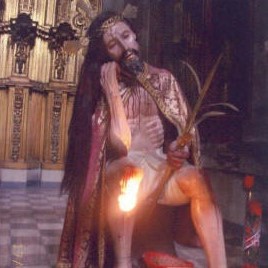
Nuestro Senor del Cacao
The cathedral at the centre of town is one of the buildings most representative of the catholic faith.
Among them, Nuestro Senor del Cacao, our Lord of Cocoa
The history of Nuestro Senor del Cacao dates back to the 16th century when Hernan Cortez began constructing a new cathedral for New Spain. To construct a new cathedral which was worthy of the colony, he had to ask for donations from the faithful.
At this time, New Spain had a double financial system. On the one hand it had introduced the Spanish monetary system and on the other, it used cocoa beans as currency.
In order to encourage people to make donations, at the entrance to the cathedral construction site, the authorities placed a statue of an Ecce Homo - the figure of Jesus Christ sitting with his crown of thorns, with an urn at his feet in which people could place their donations.
The people, happy with the idea of being able to collaborate in the construction of the cathedral and touched by the statue of the Ecce Homo, constantly filled the urn with their donations of cocoa beans. And this is how it became known as our Lord of Cocoa.
Cocoa production in Mexico in 2009
As we had already feared 2 or 3 years ago, the cocoa plantations in Mexico has been very badly infected by “monilia”
Neither the local authorities nor the farmers have paid attention to our warnings.
Monilia is a fungus that spreads very quickly from one plantation to another.
It needs to be treated very quickly and efficiently, but unfortunately that was not the case.
And yet it is quite simple to treat. We had even left a list of what measures to take.
But this requires active work on the plantation.
At least once a week it is necessary to cut off all the diseased pods in the plantation.
It is necessary to prune the top branches of the cocoa trees that prevent the sun penetrating.
It is necessary to water the trees.
Basically you have to take care of the plantation; but this has not been done, or not thoroughly.
Today there are still 37,000 cocoa farmers in Mexico for a total surface area of only 61 thousand hectares, which works out at an average of hardly 2 hectares per farmer. In fact for most of them it is even less than that because there are also much bigger plantations covering 10, 20 or more hectares.
The production of dried cocoa beans is currently just 300 to 400 kg per hectare.
The authorities estimate that total production for the whole country has dropped from around 50,000 tons to 25,000 tons, but some say the figure is more like 10,000 tons.
About 70% is produced in Tabasco, 29 % in Chiapas and 1% in Guerrero and Oaxaca.
